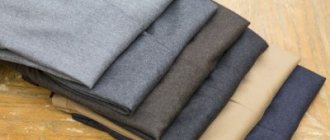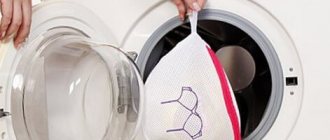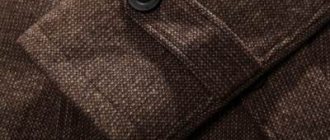Hand washing is not as popular as automatic washing. But in some cases you cannot do without it. You can wash an item by hand effectively and efficiently if you know all the features of this processing process.
Let's take a closer look at how to properly wash clothes and linen by hand, what washing products to use, whether you need to wring things out, and how to dry them.
In what cases is hand washing preferable to machine washing?
When caring for your items, hand washing can be a conscious choice or a necessity. An indication that processing should be done by hand can be found on the product label.
The following categories of things should also not be placed in the machine:
having significant wear and tear;- with contaminants that can damage the washing unit - contaminated with kerosene, gasoline, machine oil and other chemicals;
- leather and leatherette products;
- thin lace items;
- products with complex decor;
- products that have a rigid shape or frame (corsets, hats, etc.).
Manual processing has much fewer restrictions compared to machine processing, as it allows you to vary the intensity of the impact.
Exceptions include products for which dry cleaning only is permitted. For example, coats, hats and other similar products. All other things can be put in order by hand.
What cannot be washed in the washing machine
The following are not machine washable:
- Coats, hats, suits. It’s also better not to wash them by hand, but to send them straight to dry cleaning.
- Foam pillows. They can be loaded into the drum if there is a corresponding mark on the label, otherwise the product will be damaged.
- Items with animal hair stuck to them. The wool will spread even more over the clothes, get into the drum and clog the filter. Before washing by hand, the wool is removed with a sticky roller or a wet rubber glove.
- Bras. The machine can ruin your underwear, especially push-up bras.
- Items with embroidery and decor. The glued elements may come off and damage the drum or filter.
- Big and heavy things. If clothes, linens or blankets are difficult to fit into the drum, washing by hand will not remove all dirt and the equipment may break.
- Clothes made from delicate fabrics. Corduroy, cashmere, and wool can become covered with pills, snags, or tear.
Preparation for processing
Before putting things into the water, you need to go through the preparatory steps :
- Preparation of the workplace.
- Choosing a detergent.
- Determination of detergent for each specific case.
- Selecting water temperature.
- Sorting things.
At the preparation stage, there are no unimportant details, so each stage must be treated as responsibly as possible.
Workplace organization
When starting to wash by hand, you should take care of the following things:
container (basin);- detergent;
- clothespins;
- trempel;
- hangers with special clips for drying trousers;
- air conditioner;
- latex gloves.
For ease of processing, it is desirable that there are two basins, not one. One is for washing, and the second is for rinsing.
If possible, the workplace should be organized so that you do not have to constantly bend over too much . When washing in an awkward position, you can quickly get tired.
The presence of rubber gloves will reliably protect your hands from prolonged contact with household chemicals and water. If they are not used, cracks and irritation may occur on the skin.
Sorting laundry
As with machine washing, manual processing requires sorting of products. In this case, you should adhere to the following rules:
- Delicate fabrics should not be washed with rough materials.
- Black things should be treated separately from the rest, white things too.
- Shedding products are processed separately from all other products.
Depending on the material, model and degree of contamination, the intensity of the washing process and the need for pre-soaking are determined.
How to choose the right detergent?
The selection of detergent should take into account the color and composition of the fabric. For most products, it is recommended to use detergents in the form of gels rather than powders.
Such drugs have a number of advantages:
- faster dissolution in water when compared with granular formulations;
- uniform distribution in water;
- no sediment;
- good dissolution in water of any temperature (powders are easier to dilute in warm or hot water, and more difficult in cold);
- good rinsing from fabric fibers.
Careful dilution of the powder is a must. If it is violated, damage to the washable material may occur due to the contact of undissolved concentrated granules.
For some types of products, special products are produced designed for washing wool, delicate fabrics, etc.
A good result from washing can be obtained if you choose a product taking into account the color of the material:
- for black;
- for white;
- for colored.
Modern means - oxygen bleaches - can be used to remove stains. They are produced separately for colored and white clothes.
The use of chlorine bleaches is not advisable for a number of reasons:
- Chemical vapors inhaled during washing are harmful to health.
- Can be used with restrictions only on white cotton fabrics.
- Use leads to thinning of the fibers, loss of appearance, rapid wear and tear.
The simplest and most affordable laundry detergent is laundry soap. Its use is not advisable for automatic washing, but is suitable for manual processing. Another plus is that the composition is hypoallergenic, allowing the soap to be used for washing underwear and children’s underwear.
Pre-soaping most items makes washing later much easier.
Water heating temperature
The water temperature is determined based on the permissible temperature for a particular product, and taking into account the fact that it should be tolerable for the hands - no more than +50ºС. If there is no label on the item, then the water temperature is determined by the type of material:
natural linen and cotton can be processed at almost any temperature, but more often around +40ºС;- natural wool and silk – from +30ºС to +40ºС;
- viscose – up to +30ºС;
- synthetics - +40ºС;
- mixed materials – up to +40ºС or +50ºС.
If it is impossible to determine the composition, it is advisable to choose a temperature of +30 - +35ºС for washing.
Use of folk remedies
There are eight effective folk remedies that are used to remove stains from fabric.
Ash
Ash left after burning wood is often used to wash clothes. It is carefully wrapped in a gauze bag, after which it is placed in a pan with dirty things. Then the liquid is brought to a boil, soaked for 35-40 minutes and rinsed in warm water.
This method is suitable for all fabrics except delicate ones.
Mustard
Another popular folk remedy used by many housewives. Add 50 grams of mustard to a bowl of hot water. After this, the clothes are soaked in a container with the mustard mixture for about forty minutes. If the stains are absorbed into the fabric, pour mustard onto the contaminated areas and moisten with water.
Bean decoction
Some housewives use bean broth, in which they can quickly wash woolen items. To prepare such a decoction yourself, you need to add 250 grams of beans to a liter of water and boil. Then the mixture is filtered with gauze and poured into a basin with dirty laundry. It is soaked for 40-50 minutes and rinsed with vinegar liquid.
Soap root of the saponaria plant
Knitted fabric can be washed with a soap solution prepared from the root of saponaria. 60 grams of root are added to boiled water, infused and filtered. Then washing is carried out in the filtered liquid.
Potato
Woolen and fadeable fabric materials are washed in potato juice. To prepare it, 2-3 kilograms of peeled potatoes are grated, after which they are squeezed to obtain fresh juice. It is mixed with water heated to 65 degrees and poured into a basin. You can wash all items except whites in the prepared liquid.
Soap nuts
Soap nuts are popular among housewives. They are transferred to small fabric bags and placed in a basin with hot water. After this, the laundry is soaked in the container and washed by hand. Then cold water is poured into the basin and rinsing is carried out.
See also
How to properly wash a denim jacket in a washing machine, care features
Horse chestnut powder
Powder made from chestnut fruits will help fight greasy stains and serious dirt. 100-200 grams of the substance are added to a container filled with 5-6 liters of boiled hot liquid.
This product is universal, as it is used to wash any items.
Salt
To eliminate traces of blood or sweat, use table salt, which is found in every home. When creating a mixture for washing, add 100 grams of salt and vinegar to a two-liter container. Then the clothes are soaked in the liquid for half an hour.
Instructions
Having a basic knowledge of hand washing, you can begin processing according to the following scheme:
- Determine a place for washing things. It is advisable that it be located in close proximity to a water source.
- You need to pour water at the required temperature into the washing container.
- Dilute the detergent in water according to the instructions on the package.
- Stir the soap solution until foam forms and the detergent is completely dissolved.
- Dip things in water.
- If there are particularly dirty places, they need to be rubbed with soap.
- If things are dirty, they can be left in the basin for up to 20 minutes. In case of significant contamination, cotton items can be soaked for up to 3 hours, and bed linen and kitchen towels for up to 6 hours.
- Rub contaminated areas.
- Squeeze things out a little.
- If you use 2 basins, then transfer things to the second one.
- Drain the dirty water from the first one.
- Take warm water and rinse.
- Take cold water and rinse.
You need to rinse until the water is no longer soapy. If necessary, add an additional rinse.
Choice of product
To quickly get rid of dirt, you need to familiarize yourself with the basic laundry products.
Hand wash powder
Most often, housewives use washing powders that are designed for hand washing. Such products are ideal for removing any stains from fabric surfaces. It is better to use a special powder that is suitable for different types of materials.
Gel
For daily washing, it is recommended to use liquid detergents in the form of gels. Their main difference from powders is considered to be a softer effect on things. This allows you to use gels for washing items made from delicate materials. Before use, the detergent is mixed with water heated to 30-40 degrees.
Laundry soap
The most common means for cleaning clothes from dirt is laundry soap. To remove dirt, gently rub the fabric with soap, after which it is washed off with heated water. You can also make a cleaning solution from laundry soap. To do this, a soap bar is grated and diluted in water.
Hand-wringing clothes: necessary or not?
After rinsing, items should be wrung out. Twisting must be avoided so as not to deform the product.
During the spin process, you should try to remove as much water as possible . For delicate fabrics, the method of squeezing items through a terry towel is suitable.
For some types of materials, thin and delicate, for example, chiffon, polyester, it is better to exclude spinning and allow the water to simply flow over the bathtub.
Rule 4. Maintain consistency
If you don't know how to wash properly, follow the washing sequence and rules. Instructions:
- We sort things.
- Pour in the required amount of powder.
- Pour some hot water and dissolve the powder.
- Add water and monitor the temperature.
- We soak the clothes. For lightly soiled fabrics, 10–15 minutes is enough, for heavily soiled fabrics – 2–3 hours, bed linen – 10–12 hours (at night).
- We wash: three, press, etc. Particular attention to collars, bottoms of trousers, sleeve cuffs.
- Rinse, changing the water several times, until foamy powder residues no longer appear.
- Add conditioner to the last rinse.
- Wring out the laundry or let it drain.
- We hang it to dry.
Heavy items and woolen sweaters should not be wrung out by hand or hung to prevent them from stretching. Place them on a towel on a horizontal surface.. Photo: dl4.joxi.net
How to clean bulk items?
Bulky items, such as parkas and jackets, can be washed using various methods:
- Washing only certain areas of the top layer of fabric.
- Full processing.
Difficulty in washing large items:
- the volume of the thing itself;
- significant weight gain when wet;
- difficulties with spinning and drying.
In cases where a bulky item needs to be washed only from the top, it is better to avoid complete wetness, including the insulation. This type of washing is carried out by hanging the product above the bathtub.
For cleaning use a sponge or soft brush. It is convenient to rinse off soapy water using a shower head, directing it from top to bottom.
If a jacket or other bulky item needs to be washed entirely, you will have to do it right in the bathroom . Hand washing in this case will be very labor-intensive. A wet item should be processed zone by zone, carefully turning it over.
After washing, a product saturated with water requires very careful further processing. Otherwise, the insulation may become deformed, unevenly distributed and disrupt the shape of the entire thing.
To prevent this from happening, you should allow the bulk of the water to drain directly into the bathroom. And only after that proceed to drying.
Drying bulky items should be carried out by turning and repositioning the product , ensuring uniform drying.
The secret to soft towels
- When washing cotton towels, to keep them soft and fluffy, use a liquid product, preferably one labeled "Eco-Friendly."
- If you decide to use powder, repeat the additional rinse cycle to ensure the towel is soft (residual detergent may reduce the softness and make it feel rough).
- When washing cotton towels, never use silicone fabric softener (liquid or sheet); they act as water repellents and will reduce the absorbency of the towels.
Proper drying
It is recommended to dry any items in a well-ventilated area or outside.
How best to position an item for drying depends on the material, type of clothing, and size:
- blouses, shirts - on trempel;
- bedding - thrown over a rope;
- woolen and acrylic sweaters and pullovers - unfolded, etc.
You can read about all the features of drying hand-washed items here.
How is it different from other modes?
The hand wash mode is classified as a delicate wash. It differs from others in that you can wash a smaller amount of laundry at a time, the drum rotates at a slow pace, the “Spin” mode is completely absent or there is a gentle spin (in some models of automatic machines).
The “Delicate Wash” mode provides for careful treatment of the fabric and the product itself, but the drum speed is slightly increased, the amount of water consumed is greater than with manual washing, the spin function is completely turned off or switched to a gentle mode. This is the difference between hand washing and delicate washing. In hand wash mode, the process of cleaning things is gentler and more accurate.
Cotton
This option is chosen for cotton products. Cotton can withstand high temperatures without compromising its shape or properties. The maximum in the SMA is 95 degrees. Push-ups - from 1200 rpm. The duration of the cycle is 2 hours. There are also programs:
- Cotton 40 degrees - washing time 1.5 hours (90 minutes).
- Cotton 60 degrees - 1 hour 50 minutes. (110 min).
At 95°C you should not wash colored cotton fabrics, only white ones. In such hot water, dyed cotton will fade.
Why do you always need to turn your clothes inside out when washing?
Laundry day is often full of decisions:
- What detergent should I use?;
- Which cycle should I choose or should I wash it by hand?;
- Should I separate all my colors or is it ok to have some of them go in the wash together?
One question you no longer have to ask is whether you should turn your clothes inside out before washing them.
While turning items inside out before washing and then right side out again when folding can be tricky, experts say you should definitely turn your clothes inside out before washing.
Check out the reasons below that inside out is much better than right side out when it comes to how your clothes go in the washing machine.
Prevents damage to the outside of clothing.
While the washing machine is great for removing stains and leaving clothes looking and smelling fresh, clothing items can take a lot of damage while they're in the machine.
Protect your items from fading and other damage by making sure the inside of your clothing, which no one will ever see, takes the hits, not the outside.
Increases contact of detergent with the dirtiest parts of clothing.
While we sometimes use the washing machine to remove stubborn external stains such as coffee, grass or ketchup, most of the time we are looking to refresh our items from the sight of dirty clothes that a person simply wears.
During a normal day, clothes come into contact with our bodies as they move and sweat, leaving them in dire need of washing.
By turning items inside out in the washing machine, you can ensure that those sweat stains are in as close contact as possible with the detergent.
Prevents the formation of lint and pilling on the outside of clothing.
Lint and pilling is a fact of life that occurs when clothing fibers fray or break.
While washing your items inside out won't prevent wear and tear or breakage, it will ensure that this only happens on the inside of your items, keeping the exterior looking fresh and new longer.
Protects decorative clothing items from damage
If you're a fan of sparkles and rhinestones, you'll definitely want to turn your items inside out when washing them.
Although most decorative items are attached fairly well when purchased, they often become loose or damaged over time.
Storing your clothes inside out when washing them in the machine can extend the life of the glitter you love so much!
While turning clothes inside out before washing and then right side out before folding may seem like an extra step in an already complicated process, it will protect your items, keep them as clean as possible, and ensure you leave the house looking fresh and fashionable every day. !
Bottom line
Washing clothes by hand is easier than it seems.
Once you master the entire process, you will find that it only takes a few minutes and will save you money.
Happy hand washing!
See you soon! Come in!
Average score: 3
Did you like the article? Please share this with others!
Intensive wash - how long does it take?
This is the most serious and lengthy treatment. It is used in extreme cases - if things are heavily soiled and if their fabric allows the conditions offered by intensive washing:
- High water temperature. Maximum - 90–95 °C.
- Long rinse.
- The entire cycle may take 2.5–4 hours. The exact time depends on the specific model.
The disadvantage is the high consumption of water, electricity and time, as well as increased wear and tear on things. This is a test for both the machine and the laundry. Products made from cotton, linen, and synthetics can be subjected to intensive washing.
The drum should not be fully loaded. However, it should not be almost empty. 30–70% of the maximum load is the best option. The sequence of steps is followed:
- Soaking - 15–25 minutes.
- Slow rotation of the drum, then intense and slow again - each version lasts half an hour. Total 1.5 hours.
- Super rinse.
- Spin.
Attention! Each model has its own settings. The duration of processes is not regulated by any framework or standards other than expediency. Therefore, each SMA manufacturer is looking for its own optimal option.
You should resort to an intensive cycle less often - abuse of such a program of action exposes the device to increased wear. Equipment working at the limit will fail faster. The maximum frequency of use is once a month.











